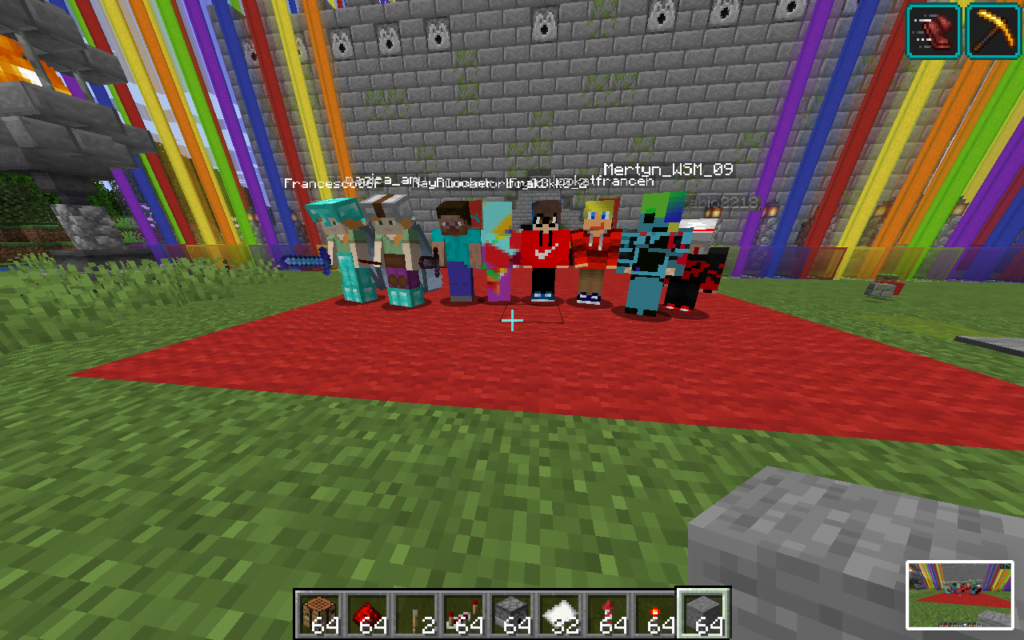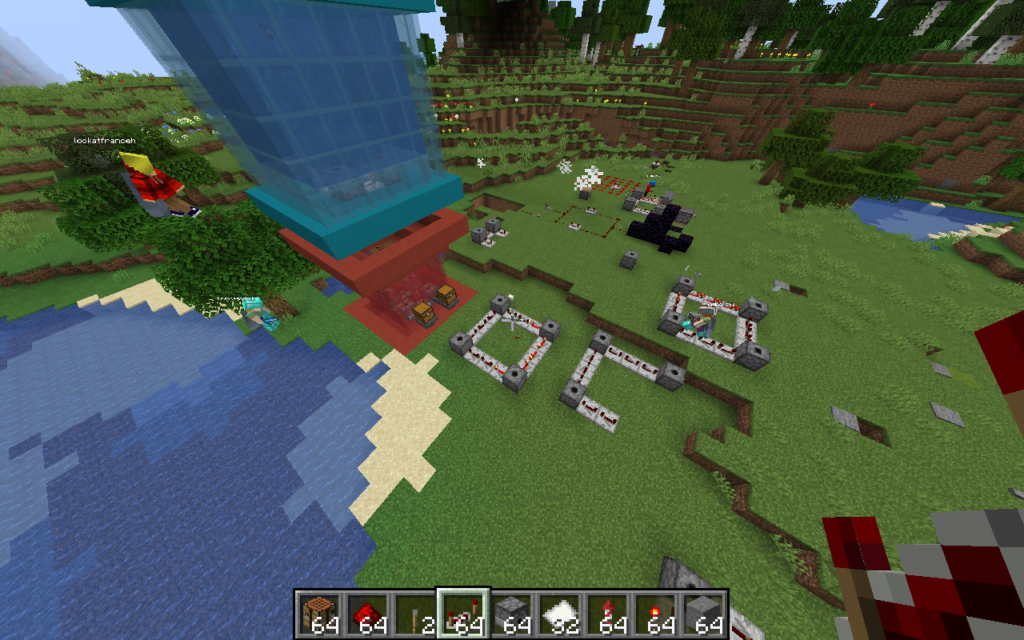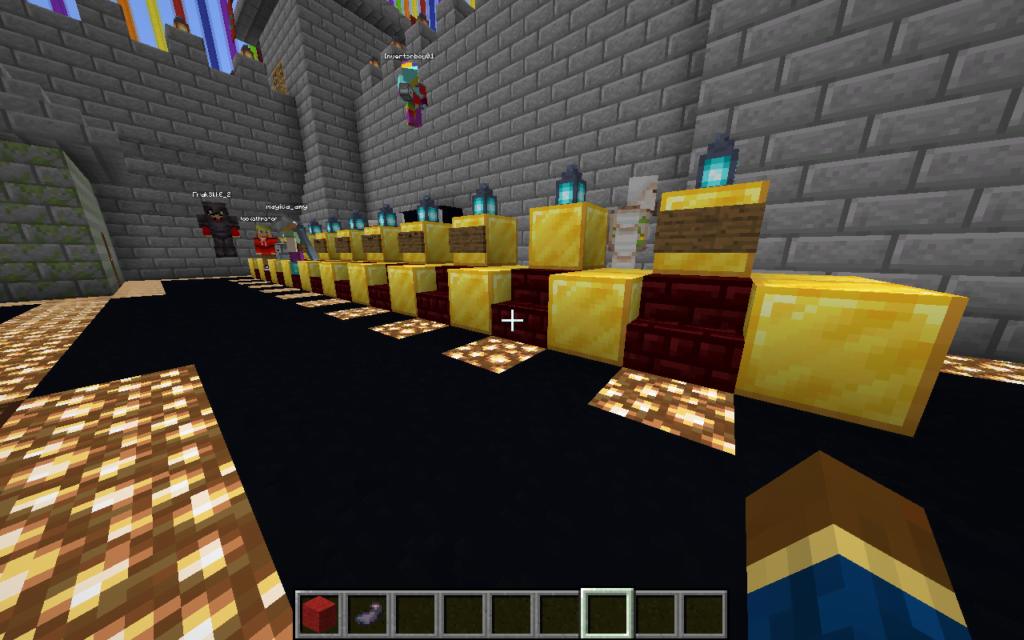Minecraft to Foster the Online Participation of Younger Kids
Year of production: 2023
Credits: in-game picture created by Michele Di Paola - Minecraft © Mojang
About the game: Minecraft
The article “Minecraft for City Planning” already extensively explained how Minecraft is one of the most played games in the world, if not the most. This is an asset in itself, because it lowers the access threshold of participants willing to use the game: many youngsters have already mastered how to play, so every activity can get straight to the point, without needing to take time explaining how to do everything.
During the mid 2010s, after successfully experimenting with many ways of engaging younger kids with technology, a mixed group of makers and youth workers (including the author) started organising summer and winter weeks based on Minecraft, which had incredible success in terms of participation and interest, with huge numbers of subscribers every time doing Minecraft activities together in the morning, and playing together outdoors in the afternoon.
This experience became an example for many other similar offers all over Italy, and when the COVID pandemic started, we had a proposal from ImpactHub Bari to host online summer weeks based on Minecraft, open to children from all over Italy.
Minecraft is popular among young boys and girls, and this is another very useful asset: in every group, we had at least a couple of female participants despite the offer (a week playing videogames online) being perceived by many as a boy-specific proposal. An ad campaign was created by the course provider, to invite female participation in the activities.
How to organise the workshop
Two groups of 10 younger boys and girls each, aged 7 to 11 years old, joined two different online week sessions from many different regions of Italy: from Lombardy to Apulia, young people over a span of 1000 km were brought together in a Zoom call, and then invited to complete some tasks in a shared private Minecraft server. We considered using Discord, as many gamers do, as a backup platform to meet, talk and solve game-related technical issues. We decided to go for Zoom to offer an experience which could be more familiar for our participants, being closer to the one all the kids just had until a few weeks before, with online school lessons delivered on every kind of platform. At that time, Zoom was the only platform offering breakout room capability, so the choice was quite easy.

Credits: in-game picture created by Michele Di Paola – Minecraft © Mojang
The challenge was first of all to establish common rules for the online spaces: a group of excited kids meeting online to play their favourite game can be quite hard to handle, and surely more difficult than within an in-presence activity, so we started by establishing rules that everybody agreed upon.
This proved to be the very first activity we had, connected to participation: even after one year of online meetings for school, nobody had taught these youngsters to behave in a way that would be respectful of others in digital spaces, so we needed to help them learn how to participate in an online environment… while setting up our participation rules.
We started with only one very clear rule: no griever players in our spaces. Nobody was allowed to destroy other players’ buildings, creations etc. inside the Minecraft world that we shared on a private server we’d set up for this purpose. Being a griever is very common behaviour for younger kids in online games, and we finally managed to get an explanation as to why directly from them: not being able sometimes to keep up with the expertise and knowledge of other players, someone would start destroying those players’ wonderful creations as an act of rage or revenge. So we sat together in a Minecraft forest, and promised each other that in our group this would never happen. If any damage were to happen unintentionally, the group agreed it should be announced to the group, and the destroyers would need to apologise and immediately help fix whatever they’d contributed to ruining.
This led to a more trusting group atmosphere and environment, and allowed us to experiment with more complex forms of participation, based on taking decisions together, supporting and helping each other’s projects and even creating complex projects from scratch: in five days, meeting online every day for 6 hours (3 in the morning and 3 in the afternoon), both groups managed to design and create their own houses, connect them into a small village, establish a transport system via underground trains (“let’s keep them underground, so the natural landscape will stay beautiful” ) and finally experimenting with electric circuits and coding of little turtle-robots, using specific community-created modifications of the game (“Mods”).

Credits: in-game picture created by Michele Di Paola – Minecraft © Mojang
It was quite impressive to notice that different children, according to their different approaches and learning styles, would either first start thinking how and what to build, or observe the surroundings to decide where to build what, or simply start building and then give form to their creations on the go.
From our side, we proposed that the group build their private houses first of all, in a defined area (around a lake), and then connect them to a street, bridges etc. to be able to easily walk from one to another. Finally, we asked them to create a transport system, based on a rail-road powered by blocks of redstone. Then, we inserted a big castle in the world they were using, and they spent the last days decorating the castle together and making it their base camp.
Quite some effort was spent on setting up participatory spaces in building activities, explaining to the children that all different approaches had reasons to be valid, and inviting them to recognise and match other participants with the same approach, and test themselves from time to time, by working with participants known to have a different approach to building and creating.
Smaller group discussions and the overall small number of participants in the online activity were the key to being able to effectively debrief every proposed task with the whole group and have time to establish rules and ways to play together. These debriefing moments were what made a difference for all participants, and again we had to define shared rules for such a discussion in online spaces, explaining how to digitally raise hands, wait for turns, respect opinions and ideas as much as creations and buildings of other participants.

Credits: in-game picture created by Michele Di Paola – Minecraft © Mojang
After a couple of attempts, discussions after each task became a habit, and soon the groups were able to acknowledge many kinds of learning taking place in the different activities, all connected to a participative approach to designing, creating, building, and fixing things together.
The mother of one participant, hearing the discussion from her son’s computer, was very impressed by the level of analysis of such young children. Being a professor at the University of Bologna, she invited us to a lecture that she gave her students about learning styles and approaches, to share this experience of Minecraft with them.
In order to play together, we recommended using a laptop and Java edition, which is cross platform and affordable. In this way, the Zoom call and the game would run on the same computer, and in the case of any technical issues, screens could be shared to help identify the problem. We also recommended participants’ families to have TeamViewer free software installed on the same laptop, so that if it were too complicated to give instructions in the case of issues, the facilitator could use TeamViewer to connect to the participant’s computer and try to solve issues directly.
Dealing with younger kids, the involvement of families was very important. We had a preparatory meeting with parents to explain all the technical needs and share the week’s programme. We had the contact number of an adult person for any emergency situations that arose during activities, because in many cases, at least for some part of the day, kids were home alone. Fortunately, we never had to use them.
During the activities we established frequent breaks with small mandatory tasks to do at home, like walking to the kitchen to drink a glass of water and then taking at least 100 steps around the house, before coming back to the laptop.
Lessons learnt
In the end, the experience proved to be a valid way to exercise and foster the participation skills of children in processes such as decision-making and common designing and building of in-game artifacts and structures, from very simple to fairly complex ones. The need for common ground with shared rules appeared as soon as the activity started to imply collaboration, and as youth workers, we were able to build on this need to introduce the wider topic of participation, often making comparisons to civic and political dimensions.
The young age of participants meant that everything had to follow a very simple plan, but even so, both groups managed to develop their skills during the five days, arriving at being able to work almost all the time alone, self-managing the group dynamics and decision-making moments.





